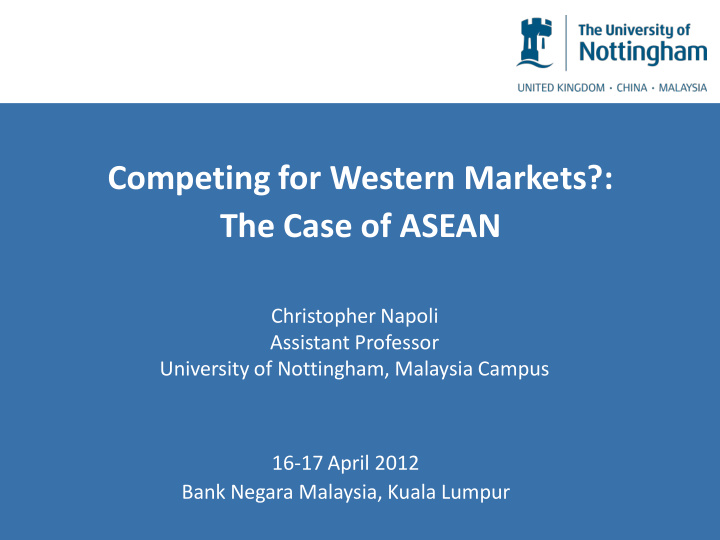



Competing for Western Markets?: The Case of ASEAN Christopher Napoli Assistant Professor University of Nottingham, Malaysia Campus 16-17 April 2012 Bank Negara Malaysia, Kuala Lumpur
Objectives of Presentation 1. An Attempt to understand the evolution of Trade and Investment flows in ASEAN countries 2. Question: Has China’s emergence as an economic superpower been a compliment or a threat for ASEAN 3. Offer a qualitative approach to compliment previous research
Trends in EU Trade (X+I) 30% 25% 20% ASEAN China India 15% USA Lat/SA Japan Africa 10% Russia 5% 0% 1999 2000 2001 2002 2003 2004 2005 2006 2007 2008 Source: Eurostat, 2011
EU trade flows with Malaysia 20,000 18,000 16,000 14,000 12,000 Millions EUR 10,000 Exports Imports 8,000 6,000 4,000 2,000 0 1999 2000 2001 2002 2003 2004 2005 2006 2007 2008 Source: Eurostat, 2011
‘Chinese Trade Theory’: The Debate China likely has the absolute advantage in the production of many products. Despite this, China’s comparative advantage in low cost labour must, by definition, come at an opportunity cost in other areas. China may increase the size of the ‘economic pie’, but… Are there switching costs from changing export destinations? How Flexible are export markets? Will China, with its single legal and political system attract more FDI ASEAN Official When talking about the ASEAN- China FTA: “If we cannot defeat you, we will join you”.
Literature Review Three Competing Theories China’s comparative advantage in low cost labour and manufacturing will crowd out ASEAN in Western markets (Lall and Albaladejo 2001) China’s growth will multiply throughout the ASEAN region (Ahearne et al. 2001; Abeysinghe and Lu in 2003) China is re-organising ASEAN into a Core and Periphery. Capital exporters will benefit while consumer goods exporters will suffer (Eichengreen 2005)
Share of ASEAN total exports sent to US, EU and China between 2000 and 2010 0.25 0.20 0.15 US EU China 0.10 0.05 - 2000 2001 2002 2003 2004 2005 2006 2007 2008 2009 2010 Source: UN Comtrade, 2012
Total ASEAN exports to Top Destinations 180 Billions USD 160 140 120 100 2000 2005 80 2010 60 40 20 - EU USA China Source: UN Comtrade, 2012
US and EU Imports from the World USA Imports USD billions Country 2000 % total Country 2010 % total World 1,258 100% World 1,966 100% Canada 232 18% China 382 19% EU 219 17% EU 321 16% Japan 150 12% Canada 279 14% Mexico 137 11% Mexico 231 12% China 108 9% Japan 123 6% ASEAN 90 7% ASEAN 112 6% EU Imports USD billions Country 2000 % total Country 2010 % total World 913 100% World 1,975 100% USA 189 21% China 373 19% Japan 84 9% USA 224 11% China 68 8% Russia 205 10% ASEAN 68 8% ASEAN 113 6% Russia 58 6% Switzerland 112 6% Switzerland 58 6% Norway 104 5% Source: UN Comtrade, 2012
Impact of China’s Rise 1. The Importance of Western Markets for China have remained strong 2. The Importance of Western Markets for ASEAN have decreased 3. The Importance of China for ASEAN has increased ASEAN Exports 2000 2010 To the EU 17% 12% To the USA 23% 12% To China 5% 16% Chinese Exports 2000 2010 To the EU 21% 18% To the USA 27% 24%
Trade Openness Indicator: Imports/GDP 0.35 0.30 0.25 0.20 US EU 0.15 China 0.10 0.05 - 1991 1992 1993 1994 1995 1996 1997 1998 1999 2000 2001 2002 2003 2004 2005 2006 2007 2008 2009 2010 Source: UN Comtrade, 2012
ASEAN Growth and Competitiveness Average Annual increase Average Real GDP growth in total ASEAN exports Country 1991-2000 2001-2010 Country 1991-2000 2001-2010 Cambodia n/a 14% Cambodia 7.00 7.86 Indonesia 10% 11% Indonesia 4.15 5.22 Malaysia 15% 9% Malaysia 7.22 4.65 Philippines n/a 6% Philippines 2.89 4.78 Singapore 10% 9% Singapore 7.23 5.69 Thailand 13% 11% Thailand 4.59 4.37 Vietnam n/a 19% Vietnam 7.58 7.27 Source: IMF, WEO 2012 Source: IMF, WEO 2012
Composition of ASEAN Exports to the World 60% 50% 40% 30% 2000 2010 20% 10% 0% Org Chem Rubber Wood Pulp & Paper Appliances Machinery Other Source: UN Comtrade, 2012
ASEAN Appliances (HS84) Exports to the World 45% 40% 35% 30% 25% 2000 20% 2010 15% 10% 5% 0% 8409 8411 8414 8415 8431 8443 8471 8473 8479 Source: UN Comtrade, 2012
ASEAN Machinery (HS85) Exports to the World 60% 50% 40% 30% 2000 2010 20% 10% 0% 8517 8523 8525 8528 8541 8542 Source: UN Comtrade, 2012
FDI Stocks in China/ASEAN, 1990-2010 1000 Billion, USD 900 800 700 600 500 China ASEAN 400 300 200 100 0 1990 1991 1992 1993 1994 1995 1996 1997 1998 1999 2000 2001 2002 2003 2004 2005 2006 2007 2008 2009 2010 Source: UNCTAD, 2012
FDI Stocks in ASEAN Country Share of ASEAN FDI and Total FDI increases Total times FDI Total times FDI Country 1990 2000 2010 Increase 1991-2000 Increase 2001-2010 Cambodia 0% 1% 1% 41.9 3.4 Indonesia n/a 3% 13% n/a 11.8 Malaysia 19% 22% 11% 4.2 3.0 Philippines 8% 8% 3% 3.6 2.4 Singapore 55% 46% 50% 3.1 4.0 Thailand 15% 12% 14% 2.9 3.8 Vietnam 3% 9% 7% 10.2 2.9 UNCTAD Database, 2012
Conclusion China appears to be crowding ASEAN out of Western markets from both a relative and absolute perspective Despite losing the West, the export competitiveness of ASEAN has not diminished Despite losing the West, ASEAN real GDP growth rates have not decreased; no evidence of a ‘core - periphery’ forming within ASEAN The composition of ASEAN exports to the world has changed only minimally, despite changes in export destinations Despite lower overall GDP growth rates, ASEAN is a more attractive destination for FDI than China; and much of the FDI into ASEAN since 2000 has come from China
Thank you
Recommend
More recommend